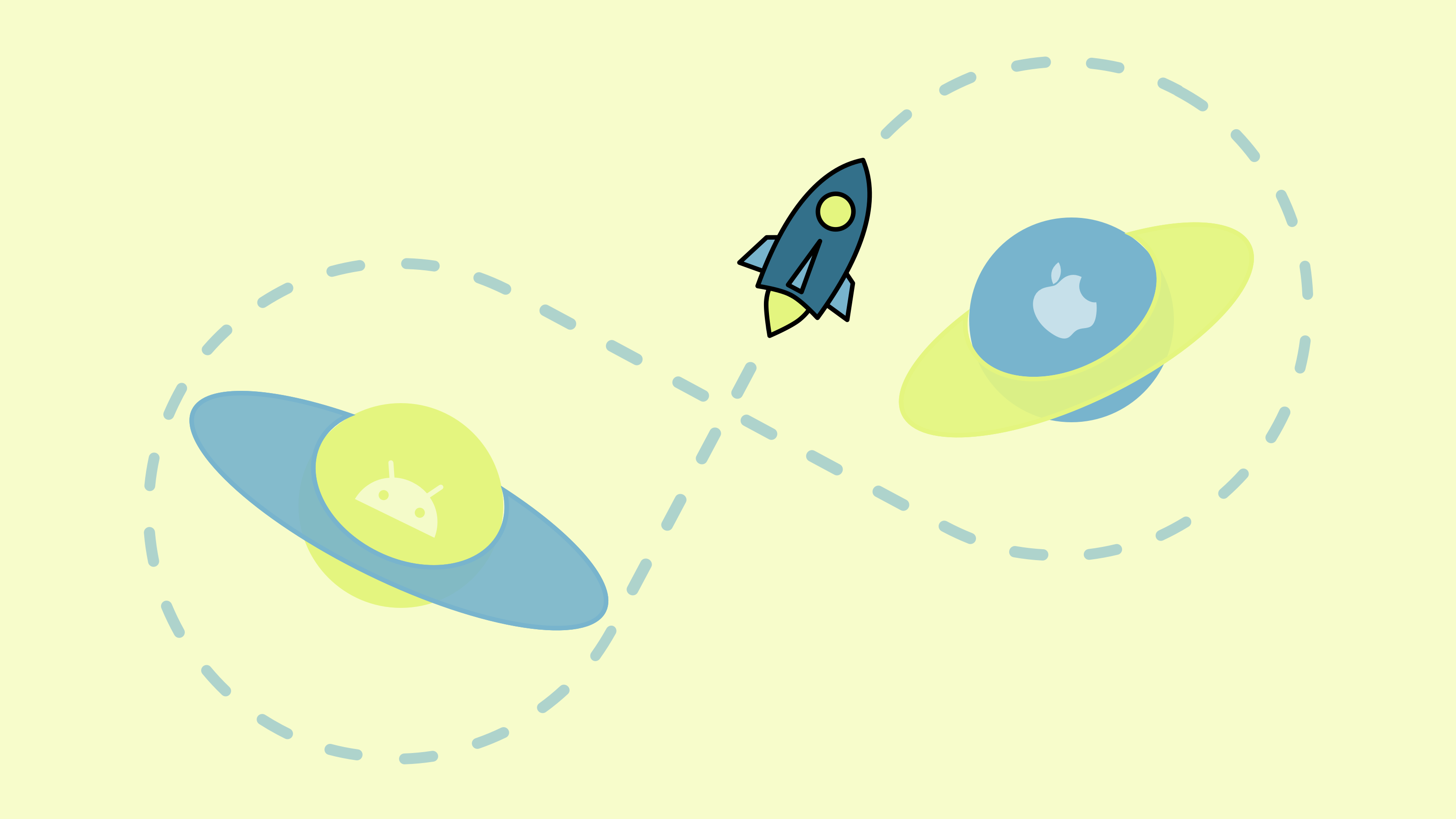
Release Your App on the App Store and Play Store. Stress-free.
Introduction
In 2023, over 25 percent of apps submitted to the Apple App Store were rejected 1.
For many people uploading an app to the Apple App Store and Google Play Store for the first time, dealing with the stores is a factor of uncertainty. I’ve experienced this myself with client projects like this one.
Especially for teams that previously worked in web development, the review process by store operators feels unfamiliar. While web apps can be released at any time based on your own decision, apps must first undergo a review. This can sometimes take several days, making short-notice deployments impossible. If an app is rejected, it can lead to even longer delays.
To prevent this from happening to you, I’m summarizing my experience with navigating the stores in this article. I’ll explain how to best plan a release, what preparations you can make early on, and how to successfully deliver your product to your customers.
The first step to avoiding stress is good planning. That’s why I’m providing you with a timeline to help you prepare for your release in a timely manner.
At the end of this article, you’ll also find a useful PDF where I’ve summarized the most important points as a checklist.
As Early as Possible
You should incorporate the following items into your project planning early in your project. This allows you to implement certain aspects during the development phase. This saves you time and stress when things get hectic before release.
Testing & Distribution: TestFlight / App Distribution
My recommendation is to think about distributing app versions as early as possible in the project. Ideally, this includes automating the build creation process and distribution to testers.
This offers several major advantages:
- Your build process is already in use before release, so you can fix errors early.
- The team becomes familiar with the process, making the release routine.
- Confidence in the code through regular successful builds. Errors are detected early.
- Easy provision of test versions allows testers and clients to provide quick and easy feedback.
The following tools are available for distributing test versions:
TestFlight: For iOS, TestFlight is perfect for distributing the app to different groups of people. This Apple tool is directly integrated into the store management system and is highly configurable. Testers can install the latest versions of the app through a dedicated app.
Android Testing: The standard option for distributing test versions is also directly integrated into Android’s store management. It allows you to upload versions to one of several channels (internal, closed, open) and make them available to testers.
Firebase App Distribution: This tool enables distribution of app builds for both Android and iOS. It’s a good option if your app already uses Firebase.
Monitoring: Bug Reporting, Analytics & Co
Another aspect I would implement early in the project is the implementation of monitoring within the app. There are two types of monitoring:
- User Analytics: helps you understand how users interact with your app (e.g., Firebase Analytics, Matomo)
- Bug Reporting: collects information about errors in the app and is essential for quality assurance (e.g., Crashlytics, Sentry)
Early integration of these monitoring solutions allows you to test their functionality early. It also allows you to implement them step by step, rather than having to implement the complete monitoring system right before release. Analytics in particular often affects nearly all parts of the app. Ideally, I add analytics directly when implementing a feature.
The effort required to implement monitoring is often overlooked. Especially during the often stressful time before a release, it’s helpful to have one less issue to deal with.
Additional tip: If you have a larger number of people testing your app early on, it’s worth investing in a contact channel now. Providing a way to give feedback directly from the app simplifies the process and increases the feedback rate.
4 Weeks Before Release
About a month before release, you should already have determined the scope of the initial release version. This is also the right time to think about the presentation of your app in the stores.
The text and images are extremely important for standing out from the competition and convincing users to download your app. Often it takes only a few seconds to decide whether an app gets installed or not. Therefore, this content should be prepared carefully and not hastily put together under time pressure just hours before the planned release.
App Store Optimization (ASO) refers to the strategic selection of content used to present an app in the stores. The right text is important because store operators use it to display the right apps for search terms. What applies to Search Engine Optimization (SEO) for search engines also applies to ASO for app stores: consider which keywords the app should be found for, and use these keywords in your store texts.
If your app is available in multiple languages, you should research the most important keywords for each language separately. A simple translation often ignores local peculiarities.
Text Content
You’ll need the following text content for your store listing:
Name
- The name of your app.
- Include your most important keyword here.
- For Android and iOS
- Length: 30 characters
Subtitle
- Displayed directly under the title
- Use different keywords than in the title
- iOS only
- Length: 30 characters
Short Description
- This description is displayed by default on the app page.
- Use different keywords than in the title
- Android only: 80 characters
Promotional Text
- Displayed above the description
- iOS only
Description
- A detailed description of your app.
- Use the most important keywords and explain the app’s functions.
- Displayed when the user clicks “more information.”
- For Android and iOS
- Length: 4000 characters
Keywords
- The most important keywords for your app
- Use keywords that you haven’t already used in the name or subtitle
- iOS only
- Length: 100 characters
What’s New
- What has changed since the last version
- For Android and iOS
- Length: 500 (Android) or 4000 (iOS) characters
Images & Videos
While text plays a significant role in the discoverability of the app, the graphical elements are extremely important in convincing users to install the app. First impressions determine whether a user opens your app’s store page or continues scrolling to a competitor.
Icon
The icon is the first thing a user sees of your app. If you manage to stand out from a list of apps, you’ve already taken the first step toward a download.
Screenshots
While the Play Store only displays icons in search results, you can also score points with screenshots of the app in the App Store. The first three screenshots are also shown in search results for iOS apps.
Nevertheless, you should also place value on good screenshots for Android. Once a user has opened the detail page in the store, take the opportunity to convince them with images of the most important features.
While Android only specifies the aspect ratio of screenshots (16:9 or 9:16), iOS screenshots must have the exact size in pixels. 2
Preview Video and App Preview
Short videos can be used to promote your app for both Android and iOS.
For Android, the video must be uploaded to YouTube. You can then enter the link to this video in the store. More detailed specifications can be found in the Play Store guidelines. 3
App Previews can be uploaded along with the screenshots. Special requirements apply to these as well. 4
Videos are optional in both stores but offer a good opportunity to convince users about your app.
Feature Graphic
For Android, in addition to screenshots, a “Feature Graphic” of 1024x500 pixels must be uploaded.
This Feature Graphic is displayed, for example, in the desktop/web version of the Play Store. It also serves as a cover image if you use a preview video.
Apple Nominations
Before releasing your app for iOS, you should also take advantage of the opportunity to nominate it for featuring in the App Store.
You can create a nomination directly in the app settings on App Store Connect. Here you can briefly explain why your app deserves a special place in the store. Even if the chance of this happening is rather small, you shouldn’t skip this opportunity.
Apple recommends nominating the app at least 3 weeks before release. 5
Privacy Policy
For both platforms, you need a link to your app’s privacy policy. You therefore need a web server somewhere to host this page. Even if you have integrated the privacy policy directly into the app, providing this link is mandatory.
Think about this early on to avoid having to set up a web server just days before the release.
Other Things You Can Prepare in Advance
In addition to the content mentioned above, there is other information that must be entered before a release, depending on the store.
Among other things, you need to provide additional privacy information, select categories, and provide contact details. Especially for legally relevant topics, it’s advisable to allow some lead time to contact experts if necessary.
Even if the topics Pricing, In-App Purchases, and Subscriptions will likely come up during development, I’d like to point out that these are also reviewed by Apple and can be rejected.
2 Weeks Before Release
The release is quickly approaching. Two weeks before the planned release date, I recommend submitting a version to the store for the first time. For this, you must have completed all the steps mentioned above, as there is no review without a complete store page.
Important! Disable automatic release after successful review in both stores.
- In iOS, the option is called “Manually release this version”.
- In Android, you must activate the “Turn on managed publishing” option in the “Publishing Overview”.
Early submission serves as a dress rehearsal for the actual release. You’ll then already be familiar with the necessary steps.
More importantly: In case of rejection, you still have enough time to fix the problems. If the app is rejected just one day before the release date, you won’t be able to publish as planned.
The Review Process
Once you’ve submitted the app, it’s time to wait. Now it’s the stores’ turn. These days, this process is relatively similar on both platforms. Your app will be in a “In Review” or “Waiting for Review” state. This can take anywhere from a few hours to several days. The first submission typically takes longer for review, as not only the app but also the store page content is checked.
If you have notifications enabled, you’ll receive a message when the review is complete. If all went well, you would now have the option to publish the app.
If your submission was rejected, you’ll find an explanation in the admin console of the respective store. This way, you’ll know what needs to be fixed before a successful release.
You can upload and submit the corrected version at any time. This way, you’ll quickly get feedback on whether your app is now accepted.
1 Week Before Release
One week before the release, it’s time to submit a final version. In the weeks before, you’ve already seen how the review process works, so the procedure should no longer be new to you.
The review probably won’t take a whole week this time either. But it’s better for your app to be ready early than to have to postpone the release.
The Release

Your app has been successfully submitted. The release day has arrived.
For the big moment, all that’s missing is a button click. “Publish Changes” on Android and “Release This Version” will launch your app to the public.
Congratulations!
Even after release, it can take a few hours before the app is displayed to all users of the stores. It’s better to wait a bit before you start promoting the app.
After the Release
But even after the release, the work isn’t completely finished. Now it’s important to keep monitoring in view and to respond quickly to customer feedback.
Probably the next features are already waiting to be released. The good thing is: You now know exactly what to do. In the past few weeks, you’ve already gone through the process several times: the app was made available for testing, feedback was incorporated, and the app was submitted, reviewed, and released.
Not so complicated after all, right?
Download
Further Information
https://www.apple.com/legal/more-resources/docs/2023-App-Store-Transparency-Report.pdf ↩︎
https://developer.apple.com/help/app-store-connect/reference/screenshot-specifications/ ↩︎
https://support.google.com/googleplay/android-developer/answer/9866151?hl=de#zippy=%2Cpreview-video ↩︎
https://developer.apple.com/help/app-store-connect/reference/app-preview-specifications ↩︎
https://developer.apple.com/help/app-store-connect/manage-featuring-nominations/nominate-your-app-for-featuring/ ↩︎


